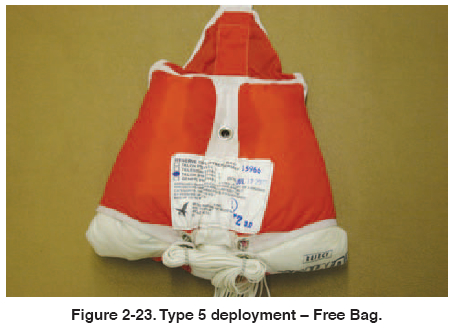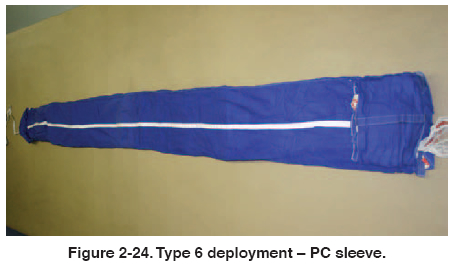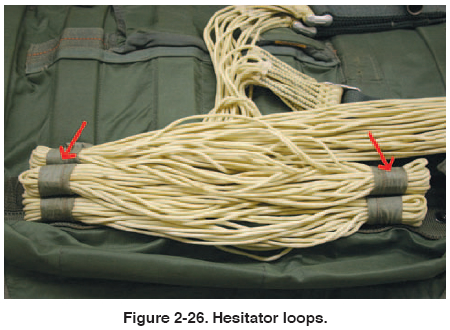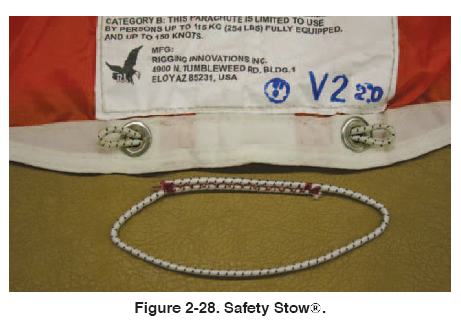Chapter 2
TYPE 5: FREE BAG
With a free bag, the canopy is stowed in the bag, and lines
are either stowed on or in the bag. They were originally
used on the Safety Flyer reserve. This is the dominant and
preferred method for virtually all modern square reserves.
[Figure 2-23]

TYPE 6: SLEEVES
This includes a fabric tube which encloses the full length
of the folded canopy. Lines are stowed on the sleeve. They
were originally used on early sport canopies, particularly
the Para-Commander. [Figure 2-24] A modern version
known as a “slag” is used on some ram-air canopies.

An additional deployment method is the “tail pocket.”
This is a fabric pocket sewn on the tail of a ram-air canopy
in which the lines are stowed. [Figure 2-25]

SECURING THE DEPLOYMENT DEVICE
With all deployment methods, it is necessary to properly
fold or stow the canopy and secure the deployment device
with the lines. The early parachutes utilized hesitator
loops to secure the lines. [Figure 2-26] This method is
still used today in many military systems.

In modern designs that utilize types 1 through 4 and 6, the
preferred method of locking the deployment device is
rubber bands. The specification for standard rubber bands
is MIL-R-1832. Type 1 are natural rubber and are 1/2" x
2". These were designed for use with the thicker Type III
nylon lines such as on the 28' C-9 canopy. Many of the
newer lightweight, round canopies use smaller diameter
and fewer lines. Consequently, the standard rubber bands
do not work well. Some manufacturers supply smaller
diameter rubber bands to be used with their canopies. It is
extremely important to utilize the correct size rubber
bands.
With the introduction of the free bag system in 1977,
Para-Flite, Inc., used a BUNA-N “O” ring to secure the
locking stows. [Figure 2-27] During testing of the free
bag system, they found inconsistent holding and breaking
strengths of rubber bands. They wanted the locking stows
to release at a consistent force to prevent bag lock. The
“O” rings provided this. A couple of years later, the “O”
rings were upgraded to a thicker diameter model. In 1983,

Para-Flite, Inc. replaced the “O” rings with the Safety
Stow®. The Safety Stow® is a continuous loop of elastic
shock cord that runs through a webbing channel and
through two grommets to secure the first two locking
stows. [Figure 2-28] In the event of any restriction on the
locking stow, as the loop stretches, it allows first one side
to release and then the opposite side. This design is a considerable
improvement over separate rubber bands or “O”
rings and is used on most free bags today.

It is important to maintain the rubber bands or Safety
Stow®. Rubber bands are susceptible to heat degradation
and dry out. If they break prematurely during use, the
parachute may malfunction. Natural rubber bands also
react to natural brass grommets and may become gummy
and sticky, causing the lines to stick to the diaper or bag.
[Figure 2-29] The BUNA-N “O” rings should be replaced
with the Safety Stow®. The Safety Stow® should be
inspected for broken stitching or internal rubber strands.
[Figure 2-30]
 
| 
